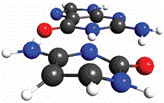Department of Chemistry
Date of this Version
2009
Document Type
Article
Citation
Journal of Computational Chemistry, Volume 31, Issue 4 (2009), pp. 778-790; DOI 10.1002/jcc
Abstract
The analytic energy gradients for the combined fragment molecular orbital and polarizable continuum model (FMO/PCM) method are derived and implemented. Applications of FMO/PCM geometry optimization to polyalanine show that the structures obtained with the FMO/PCM method are very close to those obtained with the corresponding full ab initio PCM methods. FMO/PCM (RHF/6-31G* level) is used to optimize the solution structure of the 304-atom Trp-cage miniprotein and the result is in agreement with NMR experiments. The key factors determining the relative stability of the a-helix, b-turn and the extended form in solution are elucidated for polyalanine.


Comments
US govt work.